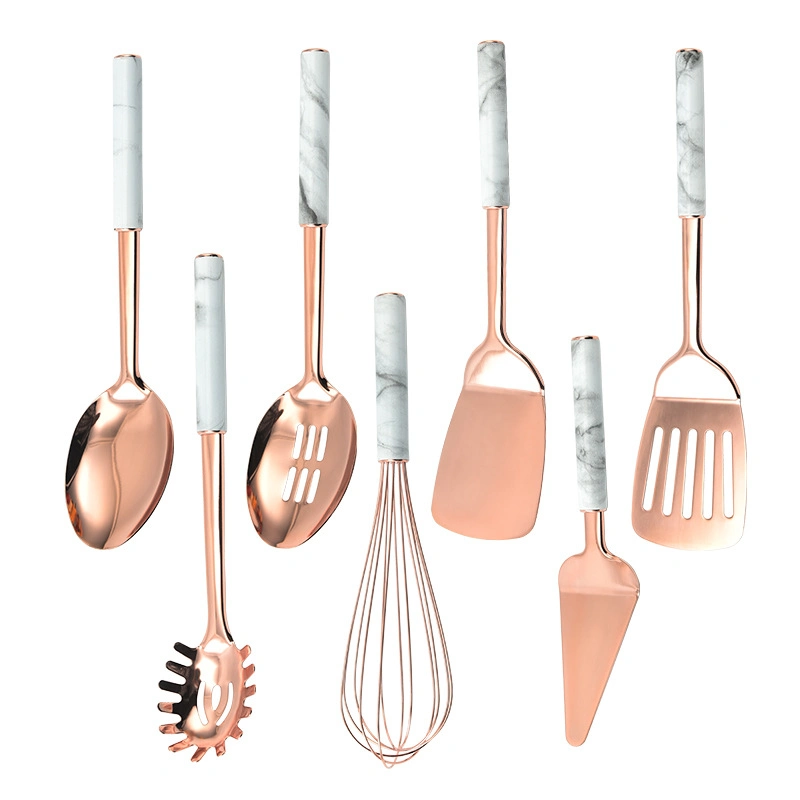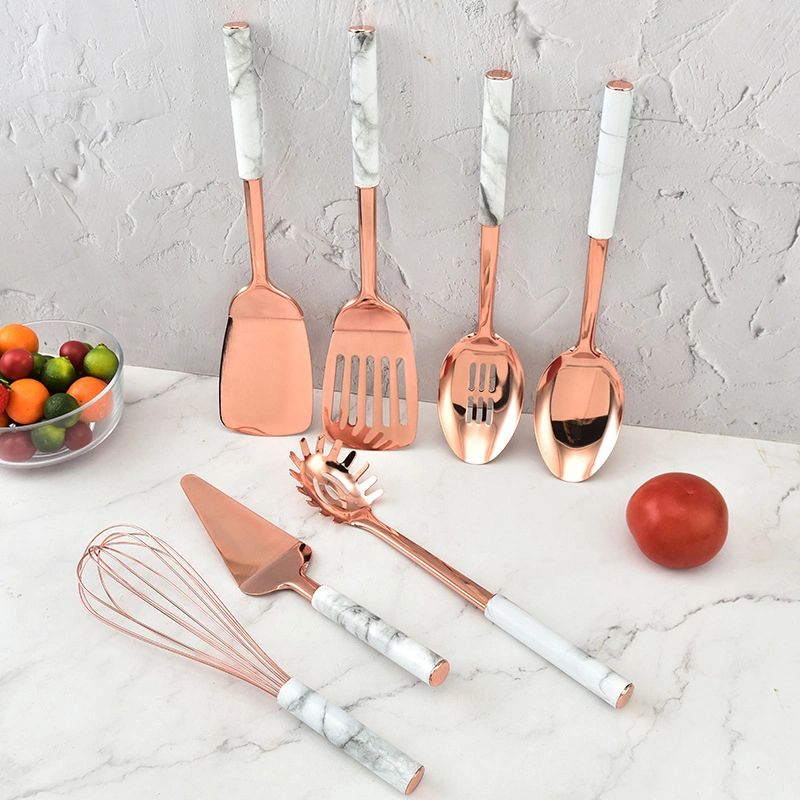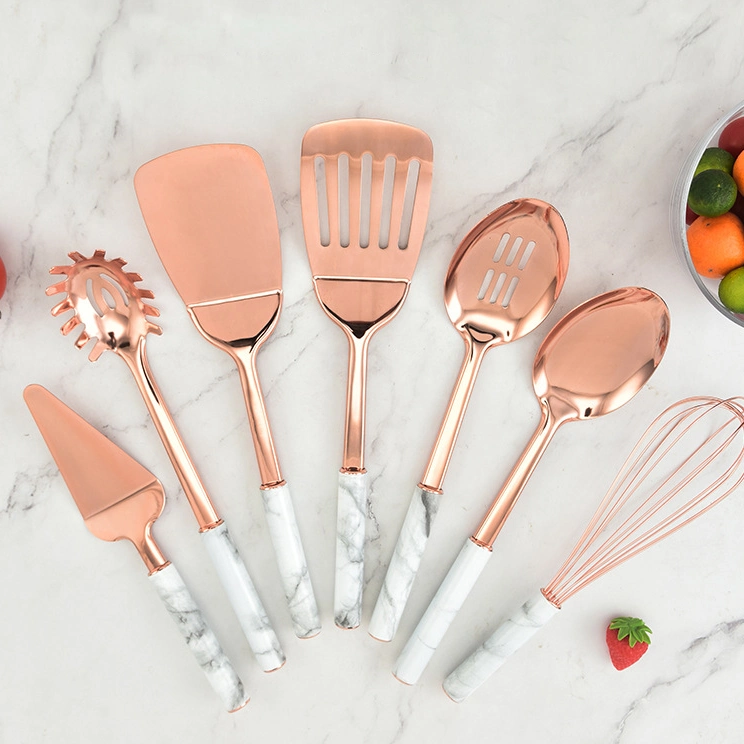Durability: Silicone Vs Stainless Steel Cooking Utensils

When considering the durability of cooking utensils, the choice between silicone and stainless steel is a significant one. Both materials offer distinct advantages and potential drawbacks, making it essential to understand their characteristics to make an informed decision. Silicone, a synthetic polymer, is known for its flexibility and heat resistance. On the other hand, stainless steel, an alloy of iron, carbon, and chromium, is celebrated for its strength and longevity.
Silicone utensils are particularly valued for their ability to withstand high temperatures without melting or warping. This heat resistance makes them ideal for tasks such as stirring hot soups or flipping pancakes on a griddle. Additionally, silicone is non-reactive, meaning it does not leach chemicals into food, ensuring safety and maintaining the integrity of flavors. However, while silicone is durable in terms of heat resistance, it is not impervious to wear and tear. Over time, repeated use and exposure to high temperatures can cause silicone utensils to degrade, leading to cracks or tears. This gradual deterioration can compromise their functionality and necessitate replacement sooner than one might expect.
In contrast, stainless steel utensils are renowned for their exceptional durability and resistance to physical damage. Unlike silicone, stainless steel does not easily bend, break, or warp, even under significant pressure. This robustness makes stainless steel utensils a long-lasting investment, capable of enduring the rigors of daily cooking without showing signs of wear. Furthermore, stainless steel is resistant to rust and corrosion, provided it is properly maintained. This resistance is due to the chromium content in the alloy, which forms a protective layer on the surface, preventing oxidation. Consequently, stainless steel utensils can maintain their appearance and functionality for many years, often outlasting their silicone counterparts.
However, it is important to note that stainless steel utensils are not without their limitations. One notable drawback is their potential to scratch or damage non-stick cookware surfaces. The rigid and abrasive nature of stainless steel can compromise the non-stick coating, reducing the effectiveness of the cookware and potentially leading to the ingestion of harmful particles. In contrast, silicone utensils are gentle on non-stick surfaces, preserving their integrity and extending their lifespan. This compatibility with non-stick cookware is a significant advantage for silicone, particularly for those who frequently use such pots and pans.
Moreover, the weight and handling of these materials also play a role in their durability. Stainless steel utensils are generally heavier than their silicone counterparts, which can be both an advantage and a disadvantage. The added weight can provide a sense of sturdiness and control, making them easier to handle during vigorous cooking tasks. However, this weight can also make them cumbersome for some users, particularly those with limited strength or dexterity. Silicone utensils, being lighter, are easier to maneuver and less likely to cause fatigue during extended use.
In conclusion, the durability of silicone versus stainless steel cooking utensils depends on various factors, including heat resistance, physical robustness, compatibility with cookware, and user handling preferences. Silicone offers excellent heat resistance and is gentle on non-stick surfaces, but it may degrade over time. Stainless steel, while exceptionally durable and resistant to rust, can potentially damage non-stick cookware and may be heavier to handle. Understanding these nuances can help individuals choose the most suitable utensils for their cooking needs, ensuring both longevity and optimal performance in the kitchen.
Heat Resistance: Comparing Silicone And Stainless Steel Utensils

When it comes to selecting cooking utensils, one of the most critical factors to consider is heat resistance. Both silicone and stainless steel utensils have their unique properties, and understanding these can help in making an informed decision. Silicone utensils, made from a synthetic rubber-like material, are known for their flexibility and non-stick properties. On the other hand, stainless steel utensils, composed of an alloy of iron, carbon, and chromium, are celebrated for their durability and strength. To appreciate the differences in heat resistance between these two materials, it is essential to delve into their respective characteristics and performance in high-temperature environments.
Silicone utensils are highly regarded for their impressive heat resistance. Typically, silicone can withstand temperatures ranging from -40°F to 500°F (-40°C to 260°C). This makes silicone utensils suitable for a variety of cooking tasks, including baking, frying, and stirring hot liquids. The material’s ability to endure such high temperatures without melting or warping is a significant advantage, particularly for home cooks who frequently work with high-heat recipes. Additionally, silicone’s non-stick nature ensures that food does not adhere to the utensils, making them easy to clean and maintain. However, it is worth noting that while silicone can handle high temperatures, it is not entirely impervious to damage. Prolonged exposure to extreme heat can cause silicone to degrade over time, potentially affecting its performance and longevity.
In contrast, stainless steel utensils are renowned for their exceptional heat resistance and robustness. Stainless steel can endure temperatures well above those that are typically encountered in everyday cooking, often exceeding 1500°F (815°C). This makes stainless steel utensils ideal for tasks that involve direct exposure to high heat, such as grilling, searing, and sautéing. The material’s inherent strength ensures that it does not warp or bend under intense heat, providing a reliable and long-lasting option for both professional chefs and home cooks. Furthermore, stainless steel’s resistance to corrosion and staining adds to its appeal, as it maintains its appearance and functionality even after repeated use.
Despite their high heat resistance, stainless steel utensils do have some limitations. One notable drawback is their tendency to conduct heat efficiently, which can result in the handles becoming hot to the touch during cooking. This necessitates the use of protective measures, such as pot holders or heat-resistant gloves, to prevent burns. Additionally, stainless steel utensils can be abrasive on non-stick cookware surfaces, potentially causing scratches and reducing the lifespan of the cookware.
In summary, both silicone and stainless steel cooking utensils offer distinct advantages in terms of heat resistance. Silicone utensils are highly heat-resistant, flexible, and non-stick, making them suitable for a wide range of cooking tasks. However, they may degrade over time with prolonged exposure to extreme heat. Stainless steel utensils, on the other hand, boast superior heat resistance and durability, making them ideal for high-heat cooking methods. Nevertheless, their efficient heat conduction and potential abrasiveness on non-stick surfaces are factors to consider. Ultimately, the choice between silicone and stainless steel utensils will depend on individual cooking needs and preferences, with each material offering unique benefits that cater to different culinary requirements.
Maintenance And Cleaning: Silicone Vs Stainless Steel Utensils

When it comes to maintaining and cleaning cooking utensils, the choice between silicone and stainless steel can significantly impact your kitchen routine. Both materials have their unique advantages and challenges, and understanding these can help you make an informed decision that suits your culinary needs.
Silicone utensils are renowned for their non-stick properties, which make them exceptionally easy to clean. Food particles rarely adhere to silicone surfaces, allowing for a quick rinse under warm water to remove most residues. For more stubborn stains, silicone utensils can be safely placed in the dishwasher, as they are resistant to high temperatures and do not warp or degrade. This dishwasher compatibility is a significant advantage for those who prefer a low-maintenance kitchen environment. Additionally, silicone is non-porous, meaning it does not absorb odors or flavors from the foods it comes into contact with, ensuring that your utensils remain fresh and hygienic over time.
In contrast, stainless steel utensils require a bit more attention to maintain their pristine condition. While they are also dishwasher safe, it is often recommended to hand wash stainless steel to preserve its shine and prevent potential water spots or discoloration. Stainless steel is highly durable and resistant to rust and corrosion, provided it is properly cared for. This involves drying the utensils thoroughly after washing to avoid any moisture-related damage. Moreover, stainless steel can sometimes develop a patina or minor scratches with regular use, which, while not affecting functionality, may be a concern for those who prefer their kitchen tools to look immaculate.
Transitioning to the aspect of durability, silicone utensils are generally more forgiving when it comes to accidental drops or rough handling. Their flexible nature means they are less likely to break or chip compared to their stainless steel counterparts. However, silicone can degrade over time if exposed to extreme temperatures or if it comes into contact with sharp objects that can cause tears or punctures. Therefore, while silicone is durable, it is not entirely impervious to damage and requires mindful use to ensure longevity.
On the other hand, stainless steel utensils are celebrated for their robustness and longevity. They can withstand high temperatures without any risk of melting or warping, making them ideal for tasks that involve direct heat, such as stirring hot soups or flipping items on a grill. The rigidity of stainless steel also means it can handle more strenuous tasks, such as scraping or deglazing pans, without bending or breaking. However, this same rigidity can be a drawback when it comes to non-stick cookware, as stainless steel utensils can scratch and damage the non-stick coating, necessitating the use of softer materials like silicone in such cases.
In conclusion, both silicone and stainless steel cooking utensils offer distinct benefits and require different approaches to maintenance and cleaning. Silicone’s ease of cleaning and non-stick properties make it a convenient choice for everyday use, especially for those who prioritize low-maintenance kitchen tools. Conversely, stainless steel’s durability and resistance to high temperatures make it a reliable option for more demanding cooking tasks, provided it is cared for properly to maintain its appearance and functionality. Ultimately, the choice between silicone and stainless steel will depend on your specific cooking habits and preferences, as well as the types of cookware you use most frequently.
Safety And Health: Silicone Vs Stainless Steel Cooking Utensils

When considering the safety and health implications of silicone versus stainless steel cooking utensils, it is essential to examine the materials’ properties, potential health risks, and overall impact on food preparation. Both silicone and stainless steel have distinct characteristics that influence their suitability for various culinary tasks, and understanding these differences can help consumers make informed decisions.
Silicone cooking utensils are made from a synthetic polymer that is flexible, heat-resistant, and non-reactive. One of the primary advantages of silicone is its ability to withstand high temperatures without melting or releasing harmful chemicals. This makes silicone utensils particularly suitable for use with non-stick cookware, as they do not scratch or damage the delicate surfaces. Additionally, silicone is non-porous, which means it does not absorb odors, flavors, or bacteria, thereby reducing the risk of cross-contamination and making it easier to clean.
On the other hand, stainless steel cooking utensils are renowned for their durability, strength, and resistance to corrosion. Stainless steel is an alloy composed primarily of iron, with chromium and nickel added to enhance its resistance to rust and staining. This material is highly resilient and can endure rigorous use without bending or breaking. Moreover, stainless steel does not react with acidic or alkaline foods, ensuring that the taste and quality of the food remain unaltered. However, it is worth noting that stainless steel utensils can scratch non-stick cookware, potentially leading to the release of harmful chemicals from the damaged coating.
When evaluating the health implications of these materials, it is crucial to consider the potential for chemical leaching. Silicone is generally regarded as safe for food contact, as it does not contain harmful substances like BPA, phthalates, or heavy metals. However, concerns have been raised about the possibility of silicone releasing small amounts of siloxanes, particularly when exposed to high temperatures. While current research suggests that the levels of siloxanes released are minimal and unlikely to pose significant health risks, it is advisable to choose high-quality, food-grade silicone utensils to minimize any potential exposure.
In contrast, stainless steel is considered one of the safest materials for cooking utensils due to its inert nature. It does not leach chemicals into food, even when exposed to high temperatures or acidic ingredients. Nevertheless, individuals with nickel allergies should exercise caution, as stainless steel can contain varying amounts of nickel, which may cause allergic reactions in sensitive individuals. Opting for utensils made from 18/8 or 18/10 stainless steel, which have lower nickel content, can help mitigate this risk.
In terms of environmental impact, both silicone and stainless steel have their pros and cons. Silicone is derived from silica, a natural resource, but its production involves energy-intensive processes and the use of non-renewable resources. Additionally, silicone is not biodegradable, although it is recyclable in specialized facilities. Conversely, stainless steel is highly recyclable and can be repurposed multiple times without losing its properties. The production of stainless steel also has a significant environmental footprint, but its longevity and recyclability make it a more sustainable option in the long run.
In conclusion, both silicone and stainless steel cooking utensils offer unique benefits and potential drawbacks in terms of safety and health. Silicone’s flexibility, heat resistance, and non-reactive nature make it ideal for use with non-stick cookware, while stainless steel’s durability and inertness ensure it remains a reliable choice for various culinary tasks. By understanding the properties and potential health implications of each material, consumers can make informed decisions that best suit their cooking needs and preferences.
